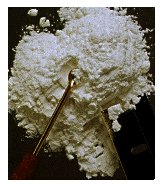Drugs Information and Drugs Factfile
Information on Drugs for everyone
Drugs Information, what you really should know about, drugs facts on and facts about Cocaine ...
A Guide for worried parents, teenagers who are using drugs or thinking about using drugs and anyone who wants to know more about the subject.
This website has been accredited by the Matthew Project in Norwich, Greater Manchester Police force and the Office of National Drug Control Policy (The White House)
Cocaine & Crack
Cocaine is a white powder that comes from the leaves of the South American coca plant. Cocaine is either "snorted" through the nasal passages or injected intravenously. Cocaine belongs to a class of drugs known as stimulants, which tend to give a temporary illusion of limitless power and energy that leave the user feeling depressed, edgy, and craving more. Crack is a smokable form of cocaine that has been chemically altered. Cocaine and crack are highly addictive. This addiction can erode physical and mental health and can become so strong that these drugs dominate all aspect's of an addict's life.
Common street names:
cocaine, crack, snow, charlie, coke, rock, wash, stone.

Cocaine |
How they are taken: Effects - cocaine |
Effects - Crack |

Crack |

Cocaine Plant |
Risks: |
| Physical risks associated with using any amount of cocaine and crack: | |||
| increases in blood pressure, heart rate, breathing rate, and body temperature | heart attacks, strokes, and respiratory failure | hepatitis or AIDS through shared needles | brain seizures |
| reduction of the body's ability to resisit and combat infection | |||
| Psychological risks: | |||
| violent, erratic, or paranoid behavior | hallucinations and "coke bugs"-a sensation of imaginary insects crawling over the skin | confusion, anxiety, and depression loss of interest in food or sex | "cocaine psychosis"-losing touch with reality, loss of interest in friends, family, sports, hobbies, and other activities. |
| Some users spend tens of thousands of pounds on cocaine and crack each week and will do anything to support their habit. Many turn to drug selling, prostitution, or other crimes. | Cocaine and crack use has been a contributing factor in a number of drownings, car crashes, falls, burns, and suicides. | Cocaine and crack addicts often become unable to function sexually. Even first time users may experience seizures or heart attacks, which could be fatal. | |
Addicts are preoccupied with getting their drug, and most of their thoughts and behaviors are directed to that end. Cocaine interferes with judgment and produces exaggerated feelings of well-being and confidence in users. High doses can produce paranoia, and users can become aggressive and violent. In rare cases, cocaine can produce death, after first use or after prolonged use. Death occurs from cardiac arrest (the person's heart stops beating), or seizures followed by respiratory arrest (the person stops breathing).
For information about other drugs, return to Drug Information Page.